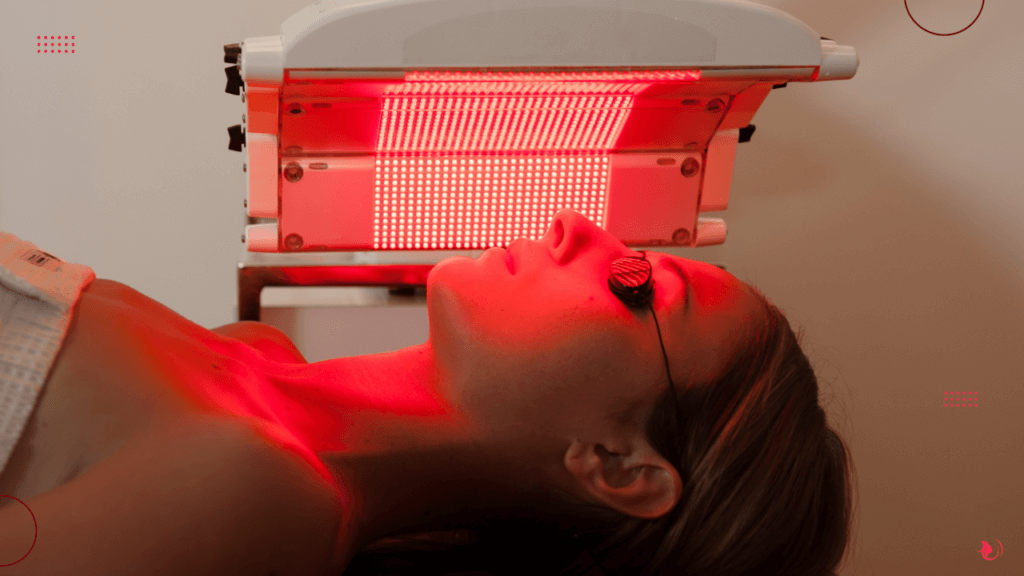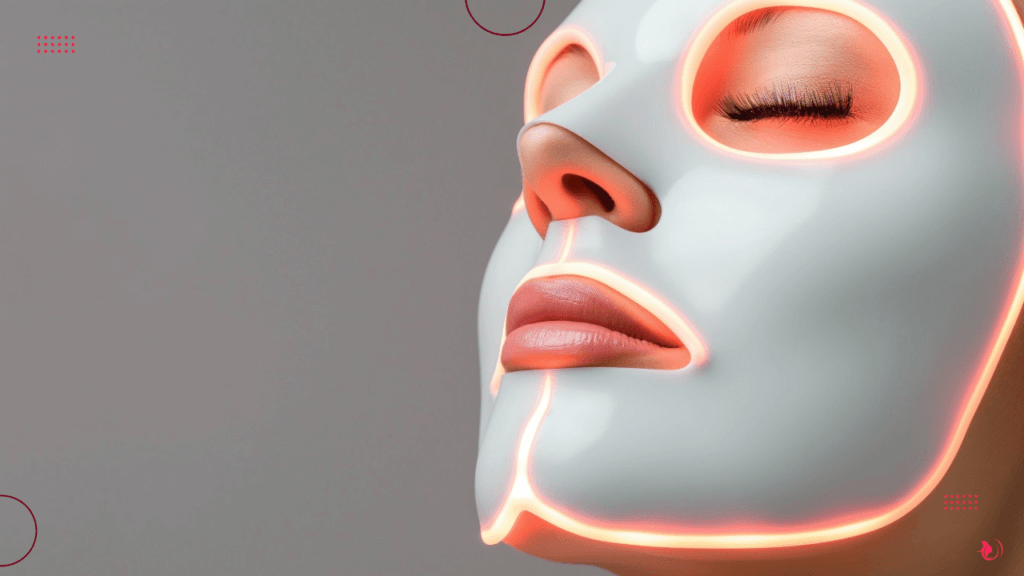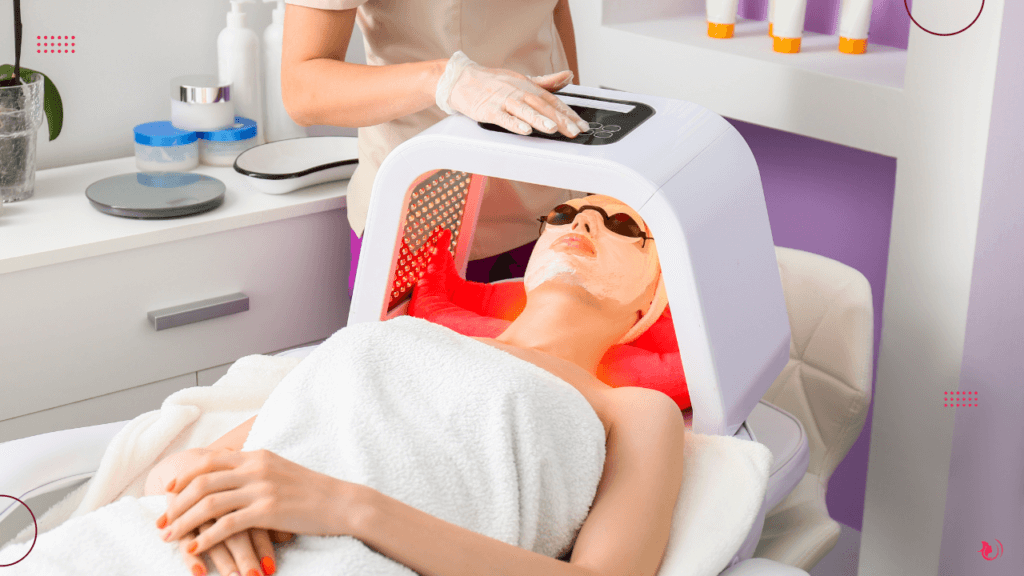Light therapy, also known as phototherapy or LED therapy, is a gentle and effective way to boost your skin’s overall health, radiance, and well-being. It works by using specific wavelengths of light to target different skin concerns, encouraging your skin to repair and rejuvenate itself.
By exposing your skin to low-level light energy from LEDs, this treatment reaches different layers of the skin to kickstart natural healing and revitalisation. Unlike sunlight, which contains harmful UV rays, therapeutic LED devices use only safe, beneficial light (aka photo) wavelengths. For example, red light may reduce inflammation and boost collagen production for younger-looking skin, while blue light can destroy acne-causing bacteria, safely.
By using these effects, light therapy offers a non-invasive way to treat multiply skin concerns without chemicals or harsh lasers.
Origins And Early Medical Uses
A century before it became a beauty trend, light therapy was pioneered in medicine. In 1903, physician Niels Finsen received the Nobel Prize for treating skin tuberculosis (lupus vulgaris) with concentrated light. Decades later, doctors discovered blue-light phototherapy could safely treat neonatal jaundice in newborns by helping break down excess bilirubin in the skin. Dermatologists also used ultraviolet light for conditions like psoriasis, eczema, and rashes, finding that controlled UV exposure could slow cell overgrowth and drastically reduce symptoms.
These early successes showed that different light wavelengths can have therapeutic benefits, laying the groundwork for the aesthetic light treatments used today. By the mid-20th century, scientific interest in phototherapy was growing. In 1967, Hungarian researcher Endre Mester made a curious discovery while experimenting with a low-powered ruby laser. In his experiment, exposed mice unexpectedly regrew their hair faster and their wounds also healed more quickly. This finding revealed that low-level light could stimulate biological processes instead of damaging tissue, a phenomenon now known as photobiomodulation. Around the same time, NASA and other scientists began exploring medical uses of light.
In fact, in the 1980s, NASA-funded studies investigated using red LEDs to stimulate plant growth in space, and astronauts noticed their cuts were healing faster under these LED-coloured lights. This serendipitous observation prompted deeper research into therapeutic light. By the 1990s, a series of NASA-supported experiments confirmed that red and infrared light can accelerate wound healing, reduce pain, and prompt cells to repair themselves. These medical developments set the stage for applying light therapy to skincare and rejuvenation.
From Medicine To Cosmetic Skincare

NASA’s work in the 1990s helped transform light therapy into a practical technology for skincare. Researchers found that high-intensity red and near-infrared LED arrays could significantly speed up tissue healing and cellular growth. Engineers like Ron Ignatius even created powerful LED devices, cheekily nicknamed “photon cannons”, that could deliver therapeutic light over a wide area. These innovations showed that non-laser light could safely energise cells, paving the way for gentler, more cosmetic-friendly uses of LED outside hospitals. By the late 1990s, dermatologists and aestheticians started heavily tapping into LED therapy to enhance skin, inspired by the unexpected beauty benefits seen in medical trials.
In the early 2000s, light therapy made its official debut in cosmetic dermatology. In 2002, the FDA approved the first blue-light device, ClearLight, as a UV-free way to target acne-causing bacteria. Just a year later, in 2003, Light BioScience introduced GentleWaves, the first LED device cleared for reducing facial wrinkles by boosting collagen production. Using carefully pulsed amber LEDs, GentleWaves offered a skin-rejuvenating treatment with absolutely no downtime.
These innovations were groundbreaking. And we mean it. For acne, doctors could now use blue light instead of antibiotics or sunlamps, and for anti-ageing, red-spectrum light could boost collagen without lasers or surgery. Dermatology clinics and med spas quickly adopted the technology. By the mid-2000s, professional LED light therapy machines had become common tools to help calm acne breakouts, speed up post-procedure healing, and revitalise ageing skin.
What began as experimental medical devices had successfully crossed over into the beauty world.
How Does Light Therapy Work For The Skin?
In a nutshell, light therapy works by delivering specific wavelengths of light into the skin, where they have distinct biological effects. The skin’s layers absorb different colours of light, blue light affects the uppermost layers, while red light penetrates deeper. This means each colour can target different skin issues.
Red light therapy (usually between 630 to 660 nm, sometimes reaching near-infrared at ~880 nm) works by penetrating deep into the skin. It gives a boost to the mitochondria, your cells’ little powerhouses, helping them work more efficiently. In your skin, this means encouraging fibroblast cells to produce more collagen and elastin, the key proteins that keep skin firm and bouncy. Research shows that red LED therapy can smooth out fine lines, and wrinkles, and improve overall skin texture by stimulating collagen production.
Red light is highly anti-inflammatory. It increases microcirculation and helps calm redness or swelling in the skin. This anti-inflammatory effect, coupled with enhanced cell growth, means red light also accelerates wound healing and tissue repair. In practical terms, red light therapy is used for anti-ageing (to firm and smooth the skin) and for healing purposes. For example, to soothe irritation, fade scars, or recover faster from procedures, it is essentially a way to encourage the skin to regenerate itself more efficiently.
Blue light (around 415 nm wavelength) is shorter in wavelength and targets the skin’s surface and pore areas. Its primary benefit in skincare is antibacterial. The bacteria that cause acne (Cutibacterium acnes) naturally produce compounds called porphyrins. When exposed to blue light, these porphyrins become activated, triggering a reaction that makes the bacteria self-destruct. Think of blue light as a gentle, natural disinfectant for your skin, helping to clear out clogged pores. Dermatologists use blue LED therapy to tackle active breakouts, often reducing pimples without the side effects of antibiotics or harsh treatments. Research also suggests that blue light can help balance oil production by influencing the skin’s oil glands, making it a great option for those struggling with excess shine.
A typical in-office acne light therapy session uses blue light to kill bacteria and often pairs it with red light to calm inflammation and promote healing. In fact, combined blue and red light has been found more effective for acne than blue light alone, since it simultaneously treats multiple factors of breakouts. Blue light is not just for acne, it is also used in medical treatments like photodynamic therapy. In this procedure, doctors apply a special light-activated solution to damaged skin (such as precancerous spots or actinic keratoses) and then use blue light to activate the medication, helping to eliminate unhealthy cells. Overall, blue light therapy is loved for its skin-purifying benefits, clearing acne, reducing bacteria, and enhancing skin clarity from the outside in.
At-Home LED Devices

In its early days, light therapy was only done in clinics or research labs, often with bulky laser equipment. Thanks to the shift from lasers to safe LED arrays, light therapy gradually became portable and simple enough for consumer use. The late 2000s marked the debut of home-use light therapy gadgets. In 2008, the FDA granted over-the-counter approval for an LED anti-wrinkle device based on GentleWaves, the first at-home light therapy mask for wrinkles. This milestone meant people could effectively “take the clinic home” for light treatments. Soon after, companies released a variety of handheld LED wands and face masks for personal use. By the mid-2010s, LED face masks (often sporting an array of red and blue lights) became a hot beauty trend, popularised by celebrity social media posts of people wearing futuristic glowing masks.
Today, light therapy is more accessible than ever. Consumers can find FDA-cleared LED masks and devices at a range of price points for use at home. These devices typically incorporate both red and blue settings, for example, a mask might offer red light mode for anti-ageing and blue light mode for acne, or even combine them in one session. While home devices are lower in intensity than professional machines, regular use can still yield benefits like a clearer complexion and smoother skin tone.
Many people incorporate LED masks into their weekly skincare routines as an extra “high-tech” step, akin to a facial treatment. The mainstream appeal lies in the ease and painlessness of these treatments, a session usually involves simply relaxing for 10 to 20 minutes under the light. As one Vogue report noted, the convenience of an at-home LED mask (to top up results between spa visits) has made the technology incredibly popular in the beauty world. What was once a niche therapy has truly entered the everyday consumer’s arsenal.
Everyday Skincare
There is an undeniable truth here. Light therapy has come a very long way. From its origins in medical experiments to becoming a key treatment of modern skincare. The journey spans over a century. What began with Finsen’s rudimentary lamps treating skin lesions has evolved into sophisticated LED wearables you can use while lounging on your couch. Along the way, scientific milestones (like NASA’s wound-healing discoveries) turned a skeptical idea into a proven treatment modality. Now we see an abundance of high-tech masks, panels, and even full-body LED beds marketed for beauty and wellness.
Light therapy’s rise to mainstream popularity highlights how far the technology has advanced and how strongly it has been embraced. Once limited to doctor’s offices, these therapies are now touted in magazines, TikTok videos, and department stores worldwide. In the span of a few decades, light therapy has transformed from a “mysterious” clinical tool to a routine self-care practice. As research continues and devices improve, consumers today can literally shine a light on their skin issues, bringing professional-grade treatment into the comfort of home, and illuminating the future of skincare with the gentle glow of LEDs.


